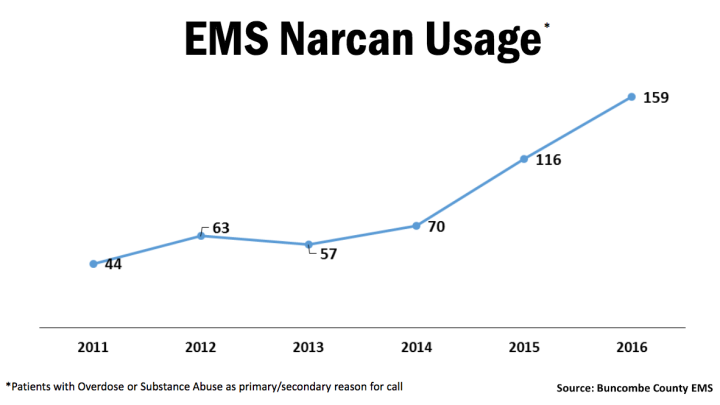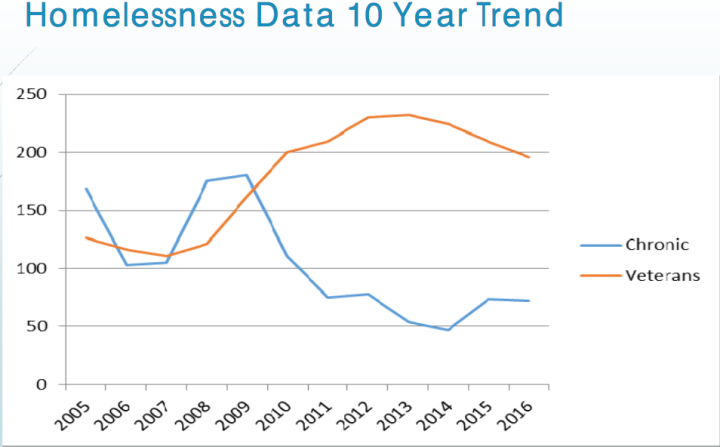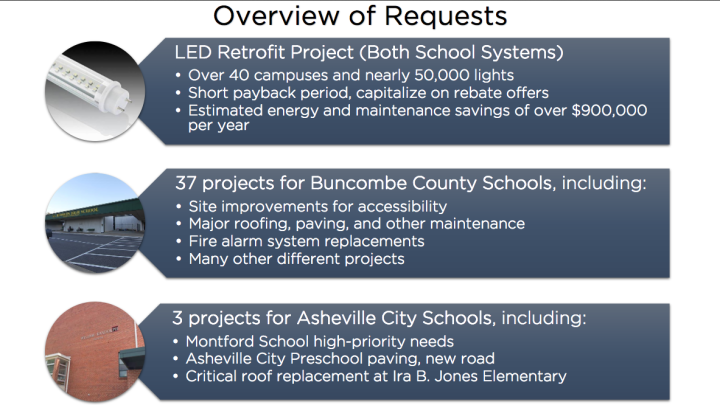In a nearly four-hour meeting on March 21, the Buncombe County Board of Commissioners unanimously pledged to fund $750,000 for a three-pronged approach to curb opioid use. No funding has been approved, and costs could fluctuate based on meetings next month, but the infrastructure for three plans looks to be all but secured. Commissioners also approved $28 million in funding for the Asheville City and Buncombe County school systems, gave support to the Five Year Strategic Plan on Homelessness and discussed pros and cons of revisiting the county’s lighting ordinance.
Growing pain
In January, commissioners asked staff to research updated statistics and best practices for potential efforts to prevent opioid use. What staff came back with was a recommendation of a three-tier approach: three community paramedics, a 14-bed recovery facility for mothers and newborns, and a media blitz aimed at education and prevention. To support this approach, county business manager Jim Holland presented recent statistics stating that for January and February, there were 150 calls to county Emergency Medical Services connected to overdoses, with 20 of those resulting in fatalities. Additionally, the use of Narcan (an overdose reversal drug) is significantly on the rise, with county personnel administering the drug 44 times in 2011 and 159 times last year.
Holland said that in the days after an overdose, an addict is most susceptible to recovery options. He noted that talking with someone who is not in a uniform can foster a more relaxed, less authoritative environment where paramedics specifically trained for these types of follow-ups can potentially help. “There may be one, two or three that say ‘Yes,’” said Holland while noting that many won’t be ready, and “that’s just the reality.” The recommendation is for the county to fund three community paramedics at a total cost of $285,000 per year.
Holland also noted that Western Carolina Rescue Mission will have 14 spots available for residential treatment in September. Those spots would allow for women to attend recovery programs while living with their newborn babies, with stipulations and supervision requirements. Last year, 154 babies in Mission-based, Buncombe County hospitals, were born with positive toxicology tests. “If those beds were ready today, we’d be able to fill them,” said Holland. He also noted they are working on partnerships with Eliada Children’s Home and the Black Mountain Home for Children, Youth and Families for similar measures. The cost to secure those beds would be $365,000 annually.
Lastly, Holland said a $100,000 educational media campaign would be able to help with prevention efforts. Currently, the county is exploring television and radio spots for these efforts and is expecting media outfits to provide in-kind public service announcements. Commissioners also noted they want to schedule town hall meetings across the county to hear from residents about what other methods could be used to prevent and fight opioid use.
Commission Chair Brownie Newman supports the media campaign but also questioned if it’s the best route. “Is there enough experience nationally that we know a media campaign works? Is there data to show it’s effective? We don’t just want to throw money at the problem,” he said.
Holland responded, “I’m not aware of a study that says if you put out advertising, you’ll see a reduction.”
“The success rate in treating addiction is not great. There’s no way around it,” lamented Newman. “Stopping it in the first place is so critical. We need to stop before it starts.” Newman then asked if people are getting hooked on opioids via medical treatment or through recreational avenues.
“Most people don’t start an addiction by shooting heroin. They get a legitimate prescription and don’t use it correctly,” replied Dr. Blake Fagan, a physician with Mountain Area Health Education Center. “You can get addicted by one prescription,” he said, noting 70-80 percent of opioid addicts start with a doctor’s prescription and after seven consecutive days of using those, the odds of addiction rise significantly.
No funding has officially been approved, but commissioners unanimously agreed to fund the $285,000 for three community paramedics at their next meeting and to start talks to secure the 14 residential spots at Western Carolina Rescue Mission’s new facility. Commissioners also want a more in-depth report on media spending, including concrete guarantees about in-kind reciprocity from television and radio stations and the potential of using billboards. That update is also set for their next meeting.
Earlier this year, Xpress had an in-depth report on opioids in Buncombe County and the fight to raise awareness about it being a health, and not a criminal, issue. You can read that report here and view Holland’s entire presentation here.
Homing in
Commissioners heard a presentation about the Five Year Strategic Plan on Homelessness, a follow-up to the Ten Year Plan to End Homelessness adopted by Buncombe County and the city of Asheville in 2005. April Burgess-Johnson, chair of the plan’s advisory committee, told commissioners that since 2006 more than 1,700 homeless people have transferred to residential opportunities. “We try to get people into housing as quick as possible and then get follow-up services,” she said.
Burgess-Johnson said the current problem is the number of veterans experiencing homelessness, noting in 2016 just under 200 vets were without a permanent residence. To reduce that number, she said, there need to be seven priorities: housing; case management; safety and transitional services; health care; education and employment; transportation; and prevention and diversion. Burgess-Johnson said there will be annual targets and goals set forth but did not identify any specifics during the presentation.
Also speaking to commissioners about the issue was Michael Woods, executive director of Western North Carolina Rescue Mission. “I agree with the plan, but prevention needs to be toward the top. Education and jobs are key,” he stressed. “We have largest emergency shelter in Buncombe County. Seventy percent of people staying in our shelter are working or in school,” he said, urging for more affordable housing to help those people transition. He also warned, “Not everyone can be taken off street, put in housing and be successful; there are other issues.”
The plan does not call for any immediate funding, and commissioners unanimously approved the plan. Specific programs of the plan could be considered for funding down the road. You can view the presentation here and read the entire plan here.
Taxing issue
County Finance Director Tim Flora presented commissioners with capital projects from city and county schools that would be funded by Article 39, a provision that earmarks part of the county’s sales tax specifically for capital projects. The two school systems identified $28 million in needs over two years and included mostly roofing repairs, repaving and other maintenance issues. “With two years of funding, projects can be bundled, and they can get better deals on some contracts,” said Flora.
County schools will get $19.4 million over two years for 37 projects, and city schools will receive $6.7 million for three projects over two years. Of that, $15 million will be made available immediately for school year 2018 projects, and the other $13 million will be available in December of this year for repairs needed during the 2019 school year.
Commissioners unanimously approved the funding, and you can view that presentation here.
Shine a light
The county’s lighting ordinance came up for discussion at the request of the Republican bloc (Commissioners Joe Belcher, Mike Fryar and Robert Pressley). At issue, according to those commissioners, is whether the current policy prevents people from feeling safe on their property. “If someone has a dusk-to-dawn light on a building somewhere in the county, and someone builds a house next to them, then the new resident complains, do those people have to change the light?” asked Belcher.
County staff informed commissioners the process is complaint-driven, meaning if a light from a home is infringing on an adjacent property, the county can be contacted to see if it needs to be mitigated by removing or shielding the footprint of the light. The bulk of Republican concerns seemed to stem from whether that mitigation prevents properties from being lit in a way residents feel safe with.
“Either we have no ordinance, so someone can shine lights into your living room; or we have an ordinance that is complaint-driven or one that is mandate-driven, requiring everyone to do [comply], and that would be a lot more intrusive. Of those options complaint-driven is better than mandating,” suggested Newman.
Belcher said none of those options sit well with him. “I don’t think either mandated or complaint-driven is good. Most these lights are in rural areas, and someone has them there to feel safe and secure,” he said. “Because of development in the county, someone can call and complain, and the person who had that light up for 20 years has to take it down.”
Fryar added that those restrictions affect some businesses because the ordinance hampers the ability to safely light some properties. “If these people want lights, let them shine them. I want to send it back to the Planning Board and make it simpler,” said Fryar, while reiterating it’s creating an anti-business climate.
Commissioners took public comment on the issue, and five people spoke in favor of keeping the ordinance as is, noting that working with your neighbor is the best solution, but having the county as a potential enforcer is a necessary safety net.
With that, commissioners voted against sending the ordinance back to the Planning Board by a vote of 4-3, with Democrats (Commissioners Jasmine Beach-Ferrara, Ellen Frost, Newman and Al Whitesides) voting against. That vote ended a two-month streak of commissioners not breaking down party lines.
Closed session
Commissioners held a closed session to discuss a legal matter, but no action was taken.
The next board meeting is scheduled for Tuesday, April 4.







In regards to Veteran’s housing if the new Trump budget proposed for HUD go through this will affect Veterans because Vets in the program need HUD vouchers to get housing. Also, as I have suggested in the past building some Vets housing is the only way to end Vet’s homelessness since there is not enough affordable housing here to do it. In regards to the Opiate treatment, thanks for this. I suggest that those in control of this provide training to police officers, Fire Dept. Workers and even the public on how to administer NARCAN to overdoses and provide those trained with the NARCAN kits. This is already done in New York and other major cities and it saves lives.
So, if you have a homeless family and the mother is an addict but the father is not it’s still better to keep the kid with the mom, give her a place to recover (a good thing) and dad can roam the streets. Or, maybe both parents are addicts. Do we take in the mother and child and break up the family or is this program only for single addict moms? What about single addict dads? What’s with the selective preference for offering help? Help shouldn’t be limited to a woMAN or a MAN. Help the huMANs.
How about we treat men with the same level of compassion as women?
In a region of that is blended in a mix of deep Christian beliefs and compassionate pagans, maybe we can all take a lesson from story of Mary and Joseph. They were both taken in cared for. Joseph wasn’t left out in the cold.
Ever see the movie “The Thinning”? I think Christian compassion has long since died.
No, but I’ll check it out. I’m no way preaching the gospel, I’m not Christian. It’s just a common point of reference and a lesson in compassion to use the Mary and Joseph story. No need to skewer the crazy bible stuff. Just take the good from wherever it comes.